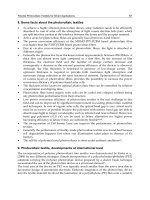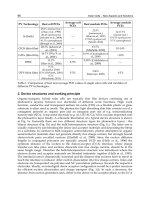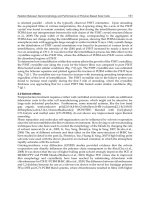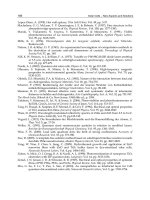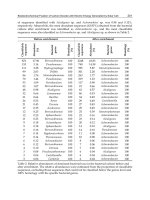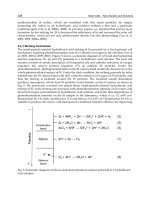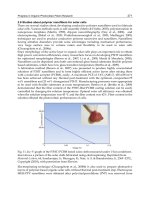Solar Cells New Aspects and Solutions Part 1 doc
Bạn đang xem bản rút gọn của tài liệu. Xem và tải ngay bản đầy đủ của tài liệu tại đây (2.08 MB, 35 trang )
SOLAR CELLS –
NEW ASPECTS
AND SOLUTIONS
Edited by Leonid A. Kosyachenko
Solar Cells – New Aspects and Solutions
Edited by Leonid A. Kosyachenko
Published by InTech
Janeza Trdine 9, 51000 Rijeka, Croatia
Copyright © 2011 InTech
All chapters are Open Access distributed under the Creative Commons Attribution 3.0
license, which permits to copy, distribute, transmit, and adapt the work in any medium,
so long as the original work is properly cited. After this work has been published by
InTech, authors have the right to republish it, in whole or part, in any publication of
which they are the author, and to make other personal use of the work. Any republication,
referencing or personal use of the work must explicitly identify the original source.
As for readers, this license allows users to download, copy and build upon published
chapters even for commercial purposes, as long as the author and publisher are properly
credited, which ensures maximum dissemination and a wider impact of our publications.
Notice
Statements and opinions expressed in the chapters are these of the individual contributors
and not necessarily those of the editors or publisher. No responsibility is accepted for the
accuracy of information contained in the published chapters. The publisher assumes no
responsibility for any damage or injury to persons or property arising out of the use of any
materials, instructions, methods or ideas contained in the book.
Publishing Process Manager Sandra Bakic
Technical Editor Teodora Smiljanic
Cover Designer Jan Hyrat
Image Copyright Carsten Reisinger, 2011. Used under license from Shutterstock.com
First published October, 2011
Printed in Croatia
A free online edition of this book is available at www.intechopen.com
Additional hard copies can be obtained from
Solar Cells – New Aspects and Solutions, Edited by Leonid A. Kosyachenko
p. cm.
ISBN 978-953-307-761-1
free online editions of InTech
Books and Journals can be found at
www.intechopen.com
Contents
Preface IX
Chapter 1 Effects of Optical Interference
and Annealing on the Performance of
Polymer/Fullerene Bulk Heterojunction Solar Cells 1
Chunfu Zhang, Hailong You, Yue Hao,
Zhenhua Lin and Chunxiang Zhu
Chapter 2 A New Guide to Thermally Optimized
Doped Oxides Monolayer Spray-Grown Solar Cells:
The Amlouk-Boubaker Optothermal Expansivity
AB
27
M. Benhaliliba, C.E. Benouis,
K. Boubaker, M. Amlouk and A. Amlouk
Chapter 3 Flexible Photovoltaic Textiles for Smart Applications 43
Mukesh Kumar Singh
Chapter 4 Dilute Nitride GaAsN and InGaAsN Layers
Grown by Low-Temperature Liquid-Phase Epitaxy 69
Malina Milanova and Petko Vitanov
Chapter 5 Organic-Inorganic Hybrid Solar Cells:
State of the Art, Challenges and Perspectives 95
Yunfei Zhou, Michael Eck and Michael Krüger
Chapter 6 Relation Between Nanomorphology and
Performance of Polymer-Based Solar Cells 121
Almantas Pivrikas
Chapter 7 One-Step Physical Synthesis of Composite Thin Film 149
Seishi Abe
Chapter 8 Cuprous Oxide as an Active Material for Solar Cells 167
Sanja Bugarinović, Mirjana Rajčić-Vujasinović,
Zoran Stević and Vesna Grekulović
VI Contents
Chapter 9 Bioelectrochemical Fixation of Carbon
Dioxide with Electric Energy Generated by Solar Cell 187
Doo Hyun Park, Bo Young Jeon and Il Lae Jung
Chapter 10 Semiconductor
Superlattice-Based Intermediate-Band Solar Cells 211
Michal Mruczkiewicz, Jarosław W. Kłos and Maciej Krawczyk
Chapter 11 Solar to Chemical Conversion Using Metal
Nanoparticle Modified Low-Cost Silicon Photoelectrode 231
Shinji Yae
Chapter 12 Progress in Organic Photovoltaic Fibers Research 255
Ayse Bedeloglu
Chapter 13 Ultrafast Electron and Hole Dynamics in
CdSe Quantum Dot Sensitized Solar Cells 287
Qing Shen and Taro Toyoda
Chapter 14 Transparent Conducting Polymer/Nitride
Semiconductor Heterojunction Solar Cells 307
Nobuyuki Matsuki, Yoshitaka Nakano, Yoshihiro Irokawa,
Mickael Lozac’h and Masatomo Sumiya
Chapter 15 High Efficiency Solar Cells via
Tuned Superlattice Structures: Beyond 42.2% 325
AC Varonides
Chapter 16 AlSb Compound Semiconductor as
Absorber Layer in Thin Film Solar Cells 341
Rabin Dhakal, Yung Huh, David Galipeau and Xingzhong Yan
Chapter 17 Photons as Working Body of Solar Engines 357
V.I. Laptev and H. Khlyap
Chapter 18 Hybrid Solar Cells Based on Silicon 397
Hossein Movla, Foozieh Sohrabi, Arash Nikniazi,
Mohammad Soltanpour and Khadije Khalili
Chapter 19 Organic Bulk Heterojunction Solar
Cells Based on Poly(p-Phenylene-Vinylene) Derivatives 415
Cigdem Yumusak and Daniel A. M. Egbe
Chapter 20 Towards High-Efficiency Organic
Solar Cells: Polymers and Devices Development 433
Enwei Zhu, Linyi Bian, Jiefeng Hai,
Weihua Tang
and Fujun Zhang
Contents VII
Chapter 21 Conjugated Polymers for Organic Solar Cells 453
Qun Ye and Chunyan Chi
Chapter 22 Optical Absorption and Photocurrent Spectra
of CdSe Quantum Dots Adsorbed on Nanocrystalline
TiO
2
Electrode Together with Photovoltaic Properties 475
Taro Toyoda and Qing Shen
Chapter 23 Investigation of Lattice Defects in
GaAsN Grown by Chemical Beam Epitaxy
Using Deep Level Transient Spectroscopy 489
Boussairi Bouzazi, Hidetoshi Suzuki, Nobuaki Kijima,
Yoshio Ohshita and Masafumi Yamaguchi
Preface
Photovoltaics covers an extremely wide range of different fields of science and
technology that are in a state of continuous development and improvement for
decades. Solar cells and models that have been developed to the level of industrial
production or prototype samples, as well as the devices of exploratory types are
divided into the so-called generations of photovoltaics. Chapters, which concern the
problems of the first, second and third generations of solar cells are included in the
relevant three books of this edition. Chapters that are general in nature or not related
specifically to these generations, some novel scientific ideas and technical solutions,
which has not properly approved, new methods of research and testing of solar cells
and modules have been collected in the fourth book of the four-volume edition of
“Solar cells”. General issues of the efficiency of a direct conversion of solar radiation
into electrical energy in solar cell and through hydrogen production in
photoelectrochemical solar cell are discussed in several chapters of the book.
Considerable attention is paid to the quantum-size effects in solar cells both in general
and on specific examples of AlGaAs superlattices, CdSe quantum dots, etc. New
materials, such as cuprous oxide as an active material for solar cells, AlSb for use as an
absorber layer in p-i-n junction solar cells, InGaAsN as a promising material for high
efficiency multi-junction tandem solar cells, InP in solar cells with semiconductor-
insulator-semiconductor structures are discussed in several chapters. Other chapters
are devoted to the analysis of both status and perspective of organic photovoltaics as
well as specific issues, such as polymer/fullerene solar cells, poly(p-phenylene-
vinylene) derivatives, photovoltaic textiles, photovoltaic fibers, etc.
It appears that the fourth book of the edition of "Solar Cells" will find many interested
readers.
The editor addresses special thanks to the contributors for their initiative and high
quality work, and to the technical editors that conveyed the text into a qualitative and
pleasant presentation.
Professor, Doctor of Sciences, Leonid A. Kosyachenko
National University of Chernivtsi
Ukraine
1
Effects of Optical Interference and Annealing on
the Performance of Polymer/Fullerene Bulk
Heterojunction Solar Cells
Chunfu Zhang
1
, Hailong You
1
, Yue Hao
1
,
Zhenhua Lin
2
and Chunxiang Zhu
2
1
School Of Microelectronics, Xidian University,
2
ECE, National University of Singapore,
1
China
2
Singapore
1. Introduction
Polymer solar cells are of tremendous interests due to their attractive properties such as
flexibility, ease of fabrication, low materials and energy budget. However, organic materials
have short exciton diffusion length and poor charge mobility, which can greatly decrease the
performance of polymer solar cells. These challenges can be effectively overcome through
the use of the bulk heterojunction (HJ) structure because it can guarantee the effective
exciton dissociation and carrier transport simultaneously if a proper bicontinuous
interpenetrating network is formed in the active layer. Based on this structure, the
performance of polymer solar cells has been improved steadily in the past decade.
The performance of a polymer solar cell is mainly determined by the short-circuit current
density (J
SC
), the open circuit voltage (V
OC
), and the fill factor (FF), given that η=J
SC
V
OC
FF/P
in
(where η is power conversion efficiency, PCE, and P
in
is the incident optical power density).
V
OC
has a direct relationship with the offset energies between the highest occupied
molecular orbital of Donor (D) material and the lowest unoccupied molecular orbital of
Acceptor (A) material (Cheyns et al., 2008). Since the D and A materials are intimately mixed
together in the bulk HJ structure and their interfaces distribute everywhere in the active
layer, it is difficult to increase V
OC
by changing D/A interface property for a given material
system (such as poly(3-hexylthiophene-2,5-diyl):[6,6]-phenyl C
61
butyric acid methyl ester,
P3HT:PCBM). Thus the usually used optimization method is to improve J
SC
and FF.
J
SC
greatly depends on the optical interference effect in polymer solar cells. Because of the
very high optical absorption ability of organic materials, the active layer is very thin and
typically from several ten to several hundred nanometers. This thickness is so thin
compared to the incident light wavelength that the optical interference effect has to be
carefully considered. Depending on the thicknesses and optical constants of the materials,
the optical interference causes distinct distributions of the electric field and energy
absorption density. Due to this effect, J
SC
shows an obvious oscillatory behavior with the
variation of active layer thickness. In order to gain a high PCE, the active layer thickness
needs to be well optimized according to the optical interference.
Solar Cells – New Aspects and Solutions
2
Besides the serious optical interference effect, J
SC
also suffers from the non-ideal free carrier
generation, low mobility and short carrier lifetime. In order to reduce the exciton loss and
guarantee the efficient carrier transport, the optimal interpenetrating network, or to say, the
optimal morphology is desired in the bulk HJ structure. In order to achieve an optimal
morphology, a thermal treatment is usually utilized in the device fabrication, especially for
the widely used P3HT:PCBM solar devices. It is found that the sequence of the thermal
treatment is critical for the device performance (Zhang et al., 2011). The polymer solar cells
with the cathode confinement in the thermal treatment (post-annealed) show better
performance than the solar cells without the cathode confinement in the thermal treatment
(pre-annealed). The functions of the cathode confinement are investigated in this chapter by
using X-ray photoelectron spectroscopy (XPS), atomic force microscopy (AFM), optical
absorption analysis, and X-ray diffraction (XRD) analysis. It is found that the cathode
confinement in the thermal treatment strengthens the contact between the active layer and
the cathode by forming Al–O–C bonds and P3HT-Al complexes. The improved contact
effectively improves the device charge collection ability. More importantly, it is found that
the cathode confinement in the thermal treatment greatly improves the active layer
morphology. The capped cathode effectively prevents the overgrowth of the PCBM
molecules and, at the same time, increases the crystallization of P3HT during the thermal
treatment. Thus, a better bicontinuous interpenetrating network is formed, which greatly
reduces the exciton loss and improves the charge transport capability. Meanwhile, the
enhanced crystallites of P3HT improve the absorption property of the active layer. All these
aforementioned effects together can lead to the great performance improvement of polymer
solar cells. Besides the thermal treatment sequence, temperature is another very important
parameter in the annealing process. Various annealing temperatures have also been tested
to find the optimized annealing condition in this chapter.
The contents of this chapter are arranged as the following: Section 2 introduces the effects of
the optical interference on J
SC
in polymer solar cells by considering the non-ideal free carrier
generation, low mobility and short carrier lifetime at the same time; Section 3 investigates
the influence of the sequence of the thermal treatment on the device performance with
emphasis on the cathode confinement in the thermal treatment; based on the optical
interference study and the proper thermal treatment sequence, the overall device
optimization is presented in Section 4. At last, a short conclusion is given in Section 5.
2. Effects of optical interference on J
SC
J
SC
is directly related to the absorption ability of organic materials. It is believed that
increasing the light harvesting ability of the active layer is an effective method to increase
J
SC
. In order to increase J
SC
, some optical models (Pettersson, 1999; Peumans et al., 2003)
have been built to optimize the active layer thickness. However, only optimizing the
thickness for better light absorption is difficult to improve J
SC
. This is because that PCE
depends not only on the light absorption, but also on exciton dissociation and charge
collection. In polymer solar cells, a blend layer consisting of conjugated polymer as the
electron donor and fullerene as the electron acceptor is always used as the active layer.
For a well blended layer, the length scale of D and A phases is smaller than the exciton
diffusion length (typically less than 10 nm), so that most of the generated excitons can
diffuse to the D/A interface before they decay. Even if all the excitons can reach the D/A
interface, not all of them can be dissociated into free carriers. The exciton-to-free-carrier
Effects of Optical Interference and Annealing on the
Performance of Polymer/Fullerene Bulk Heterojunction Solar Cells
3
dissociation probability is not 1 and depends on some factors such as electric field and
temperature. When the active layer thickness is increased to optimize the light absorption,
the electric field in the blend layer decreases, which lowers down the exciton-to-free-
carrier probability and makes charge collection less effective simultaneously. As a result,
J
SC
may become low, although the thickness has been optimized for better light
absorption. Thus to obtain a higher J
SC
, both the optical and the electric properties should
be considered at the same time.
Some previous works (Lacic et al., 2005; Monestier et al., 2007) studied the characteristic of
J
SC
. However, they neglected the influence of exciton-to-free-carrier probability, which is
important for polymer solar cells. Another study (Koster et al., 2005) considered this factor,
but they neglected the optical interference effect, which is a basic property for the very thin
organic film. All the above studies are based on the numerical method, and it is not easy to
solve the equations and understand the direct influence of various parameters on J
SC
. In this
part, a model predicting J
SC
is presented by using very simple analytical equations. Based on
this model, the effects of optical interference on J
SC
is investigated. Besides, the carrier
lifetime is also found to be an important factor. By considering the optical interference effect
and the the carrier lifetime, it is found that when the lifetimes of both electrons and holes are
long enough, the exciton-to-free-carrier dissociation probability plays a very important role
for a thick active layer and J
SC
behaves wavelike with the variation of the active layer
thickness; when the lifetime of one type of carrier is too short, the accumulation of charges
appears near the electrode and J
SC
increases at the initial stage and then decreases rapidly
with the increase of the active layer thickness.
2.1 Theory
2.1.1 Exciton generation
The active layer in polymer solar cells absorbs the light energy when it is propagating
through this layer. How much energy can be absorbed depends on the complex index of
refraction
nni
of the materials. At the position z in the organic film (Fig. 1 (a)), the time
average of the energy dissipated per second for a given wavelength
of incident light can
be calculated by
2
0
1
(, ) ()
2
j
Qz c nEz
(1)
where c is the vacuum speed of light,
0
the permittivity of vacuum, n the real index of
refraction,
the absorption coefficient, 4/
, and E(z) the electrical optical field at
point
z. (, )Qz
have the unit of
3
/Wm. Assuming that every photon generates one
exciton, the exciton generation rate at position
z in the material is given by
(, )
(, ) (, )
Qz
Gz Qz
hhc
(2)
where h is Planck constant, and
is the frequency of incident light. The total excitons
generated by the material at position z in solar spectrum are calculated by
800
300
() (, )Gz Gz d
(3)
Solar Cells – New Aspects and Solutions
4
Here the integration is performed from 300 nm to 800 nm, which is because that beyond this
range, only very weak light can be absorbed by P3HT: PCBM active layer. In inorganic solar
cells, (, )Qz
is usually modeled by
0
(, )
z
Qz I e
(4)
0
I is the incident light intensity. Here, the optical interference effect of the materials is
neglected. But in polymer solar cells, the active layers are so thin compared to the
wavelength that the optical interference effect cannot be neglected.
2.1.2 Optical model
In order to obtain the distribution of electromagnetic field in a multilayer structure, the
optical transfer-matrix theory (TMF) is one of the most elegant methods. In this method, the
light is treated as a propagating plane wave, which is transmitted and reflected on the
interface. As shown in Fig. 1 (a), a polymer solar cell usually consists of a stack of several
layers. Each layer can be treated to be smooth, homogenous and described by the same
complex index of refraction
nni
. The optical electric field at any position in the stack
is decomposed into two parts: an upstream component
E
and a downstream
component
E
, as shown in Fig. 1 (a). According to Fresnel theory, the complex reflection
and transmission coefficients for a propagating plane wave along the surface normal
between two adjacent layers
j and k are
j
k
jk
j
k
nn
r
nn
(5a)
2
j
jk
j
k
n
t
nn
(5b)
where
j
k
r and
j
k
t are the reflection coefficient and the transmission coefficient,
j
n and
k
n
the complex index of refraction for layer j and layer k. So the interface matrix between the
two adjacent layers is simply described as
22
1
1
1
22
j
k
j
k
jj
jk
jk
jk
jk
j
k
j
k
jj
nnnn
nn
r
I
r
t
nnnn
nn
(6)
When light travels in layer
j with the thickness d, the phase change can be described by the
layer matrix (phase matrix)
0
0
j
j
i
j
i
e
L
e
(7)
Effects of Optical Interference and Annealing on the
Performance of Polymer/Fullerene Bulk Heterojunction Solar Cells
5
where 2/
jjj
nd
is phase change the wave experiences as it traverses in layer j. The
optical electric fields in the substrate (subscript
0) and the final layer (subscript m+1) have
the relationship as
0 1 11 12 1
(1) ( 1)
12 22
1
01 1
m
mm
vvv mm
v
mm
EE SSE
SILI
SS
EE E
(8)
Fig. 1. Multilayer structure in a polymer solar cell. (a) the optical electric field in each layer
and (b) treating the multilayer as a virtual layer.
Because in the final layer,
1m
E
is 0, it can be derived that the complex reflection and
transmission coefficients for the whole multilayer are:
0
21
11
0
E
S
r
S
E
(9a)
1
11
0
1
m
E
t
S
E
(9b)
In order to get the optical electric field
j
E (z) in layer j, S is divided into two parts,
'"
jjj
SSLS
(10)
Where
1
'
(1) (1)
1
j
jvvvjj
v
SILI
(11a)
Solar Cells – New Aspects and Solutions
6
''
(1) ( 1)
1
m
jvvvmm
vj
SILI
(11b)
At the down interface in layer
j, the upstream optical electric field is denoted as
"
11
00
2
'" '"
11 11 12 21
j
j
jj
i
jj jj
S
EtE E
SS SSe
(12)
Similarly, at the up interface in layer
j, the downstream optical electric field is
"
21
2
0
"
11
j
j
i
jj j
j
S
EtE eE
S
(13)
The optical electric field
()
j
Ezat any position z in layer j is the sum of upstream part ()
j
Ez
and downstream part
()
j
Ez
0
() () () ( )
jj
ii
jj j j j
Ez E z E z te te E
(14)
2.1.3 Light loss due to the substrate
Because the glass substrate is very thick compared to wavelength (usually 1mm>>
wavelength), the optical interference effect in the substrate can be neglected. Here only the
correction of the light intensity at the air/substrate and substrate/multilayer interfaces is
made. As shown in Fig. 1 (b), the multilayer can be treated as a virtual layer whose complex
reflection and transmission coefficients can be calculated using above equations. Then the
irradiance to the multilayer is
*
*
00
*
0
1
()
1
i
g
i
R
IT RRI I
RR
(15)
g
I is described as
2
00
1
2
gg
IcnE
(16)
It can be derived that
*
0
0
*
0
2(1 ) *
(1 )
g
RI
E
cn RR
(17)
2.1.4 Free carrier generation
When the excitons are generated, not all of them can be dissociated into free carriers. The
dissociation probability depends on the electric field and temperature. Recently, the
Effects of Optical Interference and Annealing on the
Performance of Polymer/Fullerene Bulk Heterojunction Solar Cells
7
dissociation probability has been taken into consideration in polymer solar cells [13, 16]. The
geminate recombination theory, first introduced by Onsager and refined by Brau later, gives
the probability of electron-hole pair dissociation,
()
(,)
()
D
DX
kF
PFT
kF k
(18)
where
X
k is the decay rate to the ground state and
D
k the dissociation rate of a bound pair.
Braun gives the simplified form for dissociation rate
2
/
() 1
3
BB
UkT
DR
b
kF ke b
(19)
where a is the initial separation distance of a given electron-hole pair,
B
U
is electron-hole
pair binding energy described as
2
0
/(4 )
Br
Uq a
and
32
0
/(8 )
rB
bqF kT
. T is the
temperature, F the electric field and
r
the dielectric constant of the material. In equation
(19),
R
k is a function of the carrier recombination. For simplification, we treat
R
k as a
constant. Thus, the dissociation probability P only depends on the electric field F when the
temperature keeps constant.
2.1.5 J
SC
expression equations
J
SC
is determined by the number of carriers collected by the electrodes in the period of their
lifetime
under short circuit condition. If the active layer thickness L is shorter than the
electron and hole drift lengths (which is the product of carrier mobility
, the electric field F
and the carrier lifetime
) or in other word, the lifetimes of both types of carriers exceed
their transit time (case I as in Fig 2 (a)), all generated free carriers can be collected by the
electrodes. Considering the exciton-to-free-carrier dissociation probability P, J
SC
is
(,)
SC
JqPFTGL
(20)
where G is the average exciton generation rate in the active layer.
(a) (b) (c)
Fig. 2. Energy band diagrams under short circuit condition. (a) Case I: thickness is shorter
than both drift lengths, (b) Case II: thickness is longer than hole drift length but shorter than
electron drift length, c) Case III: thickness is longer than both hole and electron drift lengths.
Solar Cells – New Aspects and Solutions
8
If L is longer than drift lengths of electrons and holes, that is to say that the lifetimes of both
types of carriers are smaller than their transit time, the carriers are accumulated in the active
layer. At steady state, J
SC
follows Ohm’s law. Considering the exciton-to-free-carrier
dissociation probability P, J
SC
is
(,)( ) (,)( ) /
SC ee hh ee hh bi
J qPFTG F qPFTG V L
(21)
where
bi
V is the built-in potential which is usually determined by the difference between
cathode and anode work functions. This is case III as described in Fig. 2 (c).
Between case I and case III, it is case II as described in Fig. 2 (b). In this case, L is only longer
than the drift length of one type of carrier. For P3HT:PCBM based polymer solar cells, the
mobilities of holes and electrons in P3HT:PCBM (1:1 by weight) layer are
82 11
210mV s
and
72 11
310mV s
, respectively
[Mihailetchi et al., 2006]. Because the
hole mobility is one order lower than the electron mobility, holes are easy to accumulate in
the active layer, which makes the electric field non-uniform. In order to enhance the
extraction of holes, the electric field increases near the anode. On the other hand, in order to
diminish the extraction of electrons, the electric field decreases near the cathode. The electric
field is modified until the extraction of holes equal to the extraction of electrons. Goodman
and Rose studied this case and gave an equation for the photocurrent [Goodman & Rose,
1971]. Considering the exciton-to-free-carrier dissociation probability P, J
SC
is
1
22
2
(4(1) /)
(,) (1 )
2(1 )
hh
sc
cc cV L
JqPFTGLc
c
(22)
where
/( )
hh ee
c
is the drift length ratio of holes and electrons. When c<<1, the
equation is simplified to
1/2 1/2
(,)( )
sc h h
JqPFTG V
(23)
2.2 Results and discussion
2.2.1 Exciton generation profile in the active layer
For the studied bulk HJ cell, the D and A materials are well blended and form the active
layer. Because the
D and A domains are very small, we can neglect the complex reflection
and transmission at
D/A interfaces, and treat the whole active layer as one homogenous
material. All the optical constants (
n, k) of the indium tin oxide (ITO), poly(3, 4-
ethylenedioxythiophene):poly (styrene sulfonate) (PEDOT:PSS), P3HT:PCBM and the Al
electrode are input into our program, and the exciton generation rate in polymer solar cells
is calculated. If the interference effect is neglected, the exciton generation rate decreases with
the increasing thickness of the active layer as described in equation (4) which makes the
corresponding average exciton generation rate (total exciton generation rate divided by the
thickness) become smaller. However, when the optical interference effect is considered, the
modulation effect of average exciton generation rate with the thickness variation is very
clear as shown in Fig. 3. At the initial stage, the average exciton generation rate increases
with the increasing thickness of the active layer. This is because the first light peak does not
appear in the active layer when the active layer is thin due to the interference effect. With
the increase of the active layer, the first light peak approaches and enters the active layer
Effects of Optical Interference and Annealing on the
Performance of Polymer/Fullerene Bulk Heterojunction Solar Cells
9
such that the average generation rate becomes larger. With the further increase of the active
layer, the average generation rate decreases although other light peaks enter the active layer.
This is because for a thicker film, the thickness of the active layer dominates the generation
rate. This evolution of exciton generation is plotted in Fig. 4 for the 500 nm wavelength.
Fig. 3. The calculated exciton generation rate in the active layer when the optical interference
effect is considered.
0 50 100 150 200 250 300 350
0
0.5
1
1.5
2
2.5
x 10
25
0 50 100 150 200 250 300 350 400
0
0.5
1
1.5
2
2.5
x 10
25
0 50 100 150 200 250 300
0
0.5
1
1.5
2
2.5
3
x 10
25
0 50 100 150 200 250
0
1
2
3
4
x 10
25
Exciton Generation (m
-3
s
-1
)
Depth in the multilayer (nm)
Active layer: 50nm
Depth in the multilayer (nm)
Depth in the multilayer (nm)
Depth in the multilayer (nm)
ITO(nm)
PEDOT:
PSS
(nm)
Active
Layer
(nm)
ITO(nm)
ITO(nm) ITO(nm)
PEDOT:
PSS
(nm)
PEDOT:
PSS
(nm)
PEDOT:
PSS
(nm)
Active
Layer
(nm)
Active
Layer
(nm)
Active
Layer
(nm)
Active layer: 100nm
Active layer: 150nm Active layer: 200nm
0 50 100 150 200 250 300 350
0
0.5
1
1.5
2
2.5
x 10
25
0 50 100 150 200 250 300 350 400
0
0.5
1
1.5
2
2.5
x 10
25
0 50 100 150 200 250 300
0
0.5
1
1.5
2
2.5
3
x 10
25
0 50 100 150 200 250
0
1
2
3
4
x 10
25
Exciton Generation (m
-3
s
-1
)
Depth in the multilayer (nm)
Active layer: 50nm
Depth in the multilayer (nm)
Depth in the multilayer (nm)
Depth in the multilayer (nm)
ITO(nm)
PEDOT:
PSS
(nm)
Active
Layer
(nm)
ITO(nm)
ITO(nm) ITO(nm)
PEDOT:
PSS
(nm)
PEDOT:
PSS
(nm)
PEDOT:
PSS
(nm)
Active
Layer
(nm)
Active
Layer
(nm)
Active
Layer
(nm)
Active layer: 100nm
Active layer: 150nm Active layer: 200nm
Fig. 4. Evolution of exciton generation in the active layer. The light wavelength is 500 nm.
It can be seen that with the increase of the active layer thickness, the first peak enters the
active layer, which makes the average exciton generation rate become large. For very thick
film, although other peaks can enter the active layer, the absolute values for the peaks
become small, which leads to the corresponding decrease of average exciton generation rate.
Solar Cells – New Aspects and Solutions
10
2.2.2 J
SC
and the active layer thickness
Based on the calculated exciton generation rate, it is easy to predict J
SC
when the drift
lengths of both carriers are larger than the blend layer thickness. If all the generated excitons
can be dissociated into free carriers, and then collected by the electrodes,
J
SC
should be
proportional to the total exciton generation rate and behave wavelike as shown in Fig. 5
(solid line). Monestier [Monestier et al., 2007] have found this trend based on P3HT:PCBM
systems. In their experiments, the active layer thickness is varied from a few tens nanometer
to 215 nm. When the thickness is 70 nm,
J
SC
reaches the maximum value, and followed by a
little decrease until 140 nm. When the thickness increases further,
J
SC
increases again.
Unfortunately, there is obvious deviation between the prediction and the experiment
results, especially in the thick film as shown in Fig. 5 (solid line). Obviously, the assumption
that the exciton-to-free-carrier dissociation probability is unity is not correct. The influence
of dissociation probability on
J
SC
must be considered.
Fig. 5. Long carrier lifetime condition: the lifetimes of both carriers are always longer than
their transient time. Experimental data are extracted from the work (Monestier et al. 2007).
In the previous work, Mihailetchi [Mihailetchi et al., 2006] exactly predicted photocurrent of
P3HT:PCBM solar cells by assuming the same e-h separation distance (
a) and decay rate
(
X
k ). By fitting the experimental data, they obtained e-h separation distance of a=1.8 nm,
room temperature bound pair decay rate of
41
210
X
ks
for a 120 nm active layer, and
the dissociation probability is close to 90%. We use the same data and derive the parameter
81
3.9662 10
R
kS
(equation 19). The dissociation probability is calculated according to
section 2.1.4. The results are shown in Fig. 6. Obviously, the exciton-to-free-carrier
probability becomes lower with the increase of the active layer thickness. Using the results
to correct
J
SC
, another J
SC
curve is obtained and also shown in Fig. 5 (dash line). It can be
seen that the predicted
J
SC
is exactly in accordance with the experimental results. This
confirms the validity of our model. In the previous work, Monestier [Monestier et al., 2007]]
modeled
J
SC
and found that the predicted J
SC
is larger than the experimental data, especially
for the thickness larger than 180 nm. They attributed this to the thickness dependence of
optical constants. Here, according to our model, it is found that the deviation should come
from the low exciton-to-free-carrier probability for thick active layers.
Effects of Optical Interference and Annealing on the
Performance of Polymer/Fullerene Bulk Heterojunction Solar Cells
11
Fig. 6. Relations of electric field and exciton-to-free-carrier probability with layer thickness.
We have predicted
J
SC
precisely for the long enough carrier lifetime case. However, for
polymer solar cells, the performance is sensitive to the process and experimental conditions.
This may make the carrier lifetime relatively short. For P3HT:PCBM system, because the
hole mobility is one order of magnitude lower than the electron mobility, holes are easy to
accumulate in the active layer and limit the photocurrent. This is the case II as described in
section 2.1.5. By tuning the parameters to fit the experimental data, the best fitting curve is
obtained (Fig. 7) when the average hole lifetime
is
7
6.2 10 s
and exciton-to-free-carrier
dissociation probability is unity. A short lifetime
τ may imply that there are many defects.
Fig. 7. Short hole carrier lifetime condition. Left arrow: hole lifetime is longer than its
transient time; right arrow: hole lifetime is shorter than its transient time, and hole
lifetime is
7
6.2 10 s
, and electron lifetime is
6
110s
. Experimental data are from
[Li et al., 2005].
Solar Cells – New Aspects and Solutions
12
These defects increase the exciton-to-free-carrier probability. More important, the transport
process becomes the dominant limiting factor for
J
SC
, and the exciton-to-free-carrier process
becomes relatively unimportant. Then it seems that the assumption of exciton-to-free-carrier
probability as unity can satisfy the need of the prediction. In Fig. 7, we can see that there are
two regions in the fitting curve. The left region is determined by equation (20). In this
region, the lifetimes of both carriers are longer than their transient time. The solid line in the
right region is determined by equation (22). In this region, hole lifetime is shorter than its
transit time and electron lifetime is longer than its transit time.
If it is assumed that the drift length ratio of hole and electron is very small, then the
equation (23) can be used to predict
J
SC
. As shown in Fig. 7 (dash line), it can predict J
SC
very
well, which means
c<<1.
2.3 Summary
In this part, the exciton generation rate was calculated by taking the optical interference
effect into account. Based on the calculated exciton generation rate, the dependence of
J
SC
on
the active layer thickness was analyzed and compared with experimental data. Because of
the optical interference effect, the total exciton generation rate does not monotonously
increase with the increase of the active layer thickness, but behaves wavelike which induces
the corresponding variation of
J
SC
. The carrier lifetimes also influence J
SC
greatly. When the
lifetimes of both electrons and holes are long enough, dissociation probability plays an
important role for the thick active layer.
J
SC
behaves wavelike with the variation of the active
layer thickness. When the hole lifetime is too short (drift length is smaller than device
thickness), accumulation of charges appears near the electrode and
J
SC
increases at the initial
stage and then decreases rapidly with the increase of the active layer thickness. The
accordance between the predictions and the experimental results confirms the validity of the
proposed model. These results give a guideline to optimize
J
SC
.
3. Effects of annealing sequence on J
SC
The detail of the interpenetrating network, or to say, the morphology is essentially
important for the performance of polymer solar cells. In order to achieve an optimal
morphology, a thermal treatment is usually utilized in the device fabrication. The thermal
treatment can be carried out after and before the electrode deposition. Both the methods can
greatly improve the device performance. The functions of the thermal treatment have been
extensively investigated, and it has been shown that the morphology will be rearranged
through the nanoscale phase separation between donor and acceptor components during
the thermal treatment. By carefully optimizing the thermal treatment condition, an optimal
interpenetrating network can be formed, which greatly improves the charge transport
property. Besides, the thermal treatment can also effectively enhance the crystallization of
P3HT, which will increase the hole mobility and the optical absorption capability. Due to the
importance of the thermal treatment for P3HT:PCBM solar devices, great efforts have been
devoted into the study of the thermal annealing process in the past few years. How the
thermal annealing ambient, thermal annealing temperature and thermal annealing time
affect the device performance has been well studied. However, only very few studies paid
attention to the role of cathode in the thermal treatment. As is known, the thermal treatment
can be done before and after the cathode deposition and both methods can greatly improve
the device performance. The unique difference between them is whether there is cathode
confinement in the thermal treatment or not. Although most of the previous studies have
Effects of Optical Interference and Annealing on the
Performance of Polymer/Fullerene Bulk Heterojunction Solar Cells
13
tended to use the cathode confinement and carry out the thermal treatment after the cathode
deposition, what are the functions of the cathode confinement in the thermal treatment and
how they affect the device performance are still not well studied.
In this part, the effects of cathode confinement on the performance of polymer solar cells are
investigated. It is shown that a better device performance can be achieved by using the
cathode confinement in the thermal treatment. The experimental analysis indicates that by
capping the cathode before the thermal treatment, the Al-O-C bonds and P3HT-Al
complexes are formed at the interface between the P3HT:PCBM active layer and the
cathode, which leads to a better contact and thus improves the charge collection capability.
More importantly, the cathode confinement in the thermal treatment greatly improves the
active layer morphology. It is shown that the cathode confinement in the thermal treatment
can effectively inhibit the overgrowth of the PCBM molecules, and at the same time increase
the crystallization of P3HT. Thus, a better morphology is achieved, which effectively
reduces the exciton loss and improves the charge transport capability. Meanwhile, the
enhanced P3HT crystallites improve the absorption property of the active layer. All these
effects contribute to improve the device performance.
3.1 Experimental
Fig. 8 shows the layer structure of our polymer solar cells and the chemical structures of
P3HT and PCBM. All the devices were fabricated on the ITO-coated glass substrates. Briefly,
after being cleaned sequentially with detergent, de-ionized water, acetone, and isopropanol
in an ultrasonic bath for about 15 mins, the dried ITO glass substrates were treated with
oxygen plasma for about 3 mins. Then the filtered PEDOT:PSS (Baytron P VP AI 4083)
suspension (through 0.45
m
filter) was spun coated on top of the ITO surface to form a ~50
nm layer under ambient condition, and dried at 120
o
C in an oven for about one hour.
Fig. 8. Layer structure of the polymer solar cells investigated in this work.
P3HT:PCBM solution dissolved in 1,2-dichlorobenzene with a weight ratio of 1:0.8 was then
spun coated on the PEDOT:PSS layer in the glove box to form a 100 nm blend layer. A 100
nm Al cathode was further thermally evaporated through a shadow mask giving an active
device area of 20 mm
2
. In order to investigate the effects of the cathode confinement on the
device performance in the thermal treatment, two different types of devices were
investigated: the devices without the cathode confinement in the thermal treatment (anneal
the devices before the cathode deposition, pre-anneal) and the devices with the cathode
confinement in the thermal treatment (anneal the devices after the cathode deposition, post-
Solar Cells – New Aspects and Solutions
14
anneal). The thermal treatment was carried out by annealing the devices in the glove box at
the optimized temperature of 160 °C for about 10 mins as our previous report [Zhang et al.,
2008]. For reference, the devices without any thermal treatment were also fabricated.
The current-voltage (
J-V) characteristics were measured by a Keithley 2400 source-measure
unit under AM 1.5 solar illumination at intensity of 100 mW/cm
2
calibrated by a Thorlabs
optical power meter. The XPS samples were consisted of an identical sandwiched structure:
ITO coated glass/P3HT:PCBM(100 nm)/Al (3 nm). Because XPS is a surface chemical
analysis technique (top 1-10 nm usually), here only a very thin metal layer is used as others
[39]. The XPS spectra were measured by transferring the samples to the chamber of a Kratos
AXIS HSi spectrometer at once. The operating pressure of the analysis chamber was
maintained at 8x10
-9
Torr. A 1486.71 eV monochromatic Al K x-ray gun source was used to
achieve the Al 2p, O 1s, C 1s and S 2p spectra. Tapping mode AFM measurements were
taken with a Nanoscope III A (Digital Instruments) scanning probe microscope. The samples
were prepared in the same sequence as the XPS samples. The phase images and the line
scanning profiles of the samples were then recorded under air operation. For both the
optical absorption study and x-ray diffraction measurement, the thin films of P3HT:PCBM
in the same thickness of 100 nm were spun cast on the microscope slides. The optical
absorption study was recorded by a Shimadzu UV-3101 PC UV-VIS-NIR scanning
spectrophotometer. The XRD measurement was carried out by the θ-2θ scan method with
CuKα radiation (
= 0.1542 nm) using a Shimadu X-Ray diffractometer.
3.2 Results and discussion
Fig. 9 shows the J-V characteristics of the devices with the same configuration of
ITO/PEDOT:PSS/P3HT:PCBM/Al. For the device without any thermal treatment, it shows
the solar response with
J
SC
of 5.12 mA/cm
2
, V
OC
of 0.58 V, FF of 47.63% and PCE of 1.41%.
The device performance is greatly improved by the thermal treatment. However, there are
obvious differences for the devices with and without the cathode confinement in the thermal
treatment as shown in Fig. 9 and Table 1. For the device without the cathode confinement in
the thermal treatment, it shows the performance of
J
SC
=7.50 mA/cm
2
, V
OC
=0.58 V,
FF=57.13% and PCE=2.49%. However, a further performance improvement is observed for
the device with the cathode confinement in the thermal treatment, which shows a better
performance of
J
SC
=8.34 mA/cm
2
, V
OC
=0.60 V, FF=62.57% and PCE=3.12%. It can be seen
that the cathode confinement in the thermal treatment effectively increases
J
SC
and FF, which
makes the overall
PCE improved by 25%. This trend was found for a series of cells. Similar
results are reported recently [Kim et al, 2009] where they also observed that the device with
thermal treatment after cathode deposition could show a better performance. This further
confirms our experimental results.
Samples V
OC
J
SC
FF PCE J
0
J
ph
n R
sh
R
s
Without thermal treatment 0.58 5.13 47.64 1.42 2.75e-4 5.32 2.32 778.25 29.00
Without cathode confinement 0.58 7.50 57.13 2.49 4.80e-5 7.62 1.89 575.19 9.34
With cathode confinement 0.60 8.34 62.25 3.12 3.03e-5 8.40 1.88 617.28 4.43
Units of parameters, V
OC
: V; J
SC
, J
0
and J
ph
: mA/cm
2
; FF and PCE: %; R
sh
and R
s
: cm
2
.
Table 1. Summary of the Parameters Extracted from the J-V Curves Shown in Fig. 9
Effects of Optical Interference and Annealing on the
Performance of Polymer/Fullerene Bulk Heterojunction Solar Cells
15
Fig. 9.
J-V characteristics of the solar cells under the AM 1.5 illumination with the light
intensity of 100 mW/cm
2
. The devices without (circle) and with (triangle) the cathode
confinement in the thermal treatment and the device without any thermal treatment (squire)
are shown in the graph. Solid lines are the fitting curves according to equation (24).
In order to understand the functions of the cathode confinement in the thermal treatment,
the electrical parameters need to be extracted. The
J-V characteristics of organic solar cells
can be described approximated by the Shockley equation
0
1
S
B
qV RJ
nk T
S
p
h
Sh
VRJ
JJe J
R
(24)
Where J
0
, J
ph
, R
s
, R
sh
, q, n, k
B
and T are the saturation current density, the photocurrent
density, the series resistance, the shunt resistance, the electron charge, the ideality factor, the
Boltzmann constant and the temperature, respectively. By fitting the Shockley equation (Fig.
9), the estimated parameters are extracted and listed in Table 1. It is shown that R
s
of the
device with the cathode confinement in the thermal treatment is greatly reduced compared
to the device without the cathode confinement in the thermal treatment (from 9.34 cm
2
to
4.43 cm
2
). R
s
can significantly affect the device performance and reducing the value of R
s
is
an efficient method to increase PCE. The reduced R
s
by using the cathode confinement plays
one main role for the significant performance improvement of polymer solar cells. R
s
is
directly related to the contacts between the cathode and the active layer. Thus, these contacts
were addressed by the XPS measurement.
The interfacial analysis results obtained by XPS measurement are shown in Fig. 10. Each top
curve and bottom curve in the Al 2p, C 1s, O 1s and S 2p core level spectra graphs are
corresponding to the samples with and without cathode confinement in the thermal
treatment. As shown in Fig. 10, both samples show the Al 2p spectrum peaks located at the
binding energy (BE) of 74.95 eV and 74.6 eV, which are corresponding to the Al oxide and
Al-O-C bond, respectively, by referring to Table 2. The Al-O-C bond is also confirmed by the
peaks located at the BE of 286.2 eV in the C 1s spectrum and 531 eV in the O 1s spectrum as


